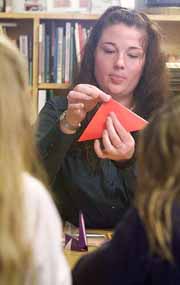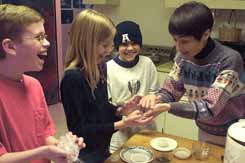Sixth-graders learn about Asian culture from USU club
Not many sixth-graders — or college students, for that matter — have tasted seaweed. Nor are most of them aware of how much dehydrated seaweed expands in water.
But students in a sixth-grade class at the Cache Valley Learning Center now know all about seaweed and other aspects of the Japanese culture, thanks to the Japanese Club at Utah State University.
The club visited the classroom Friday afternoon and taught the students how to cook Japanese food, make origami and write in calligraphy.
This is the first community service project the club has done this school year, and the first ever project of its kind for the club, said Cleveland Karren, the club’s president.
“It’s been so much fun so far, and I really enjoy it,” Karren said.
At the food station, Mitsuko Hirata, who teaches Japanese at USU, showed the students how to make a traditional Japanese dish called rice balls. They put rice around corned beef and rolled it into a ball. Then they wrapped seaweed around it.
“It’s pretty good, but I like steak,” said Aaron Johnson, one of the 11 members of the sixth-grade class.
The Japanese commonly use fish instead of beef, but Hirata said she was worried the children wouldn’t eat it.
The sixth-graders were most impressed with dehydrated seaweed, which expanded from about the size of a safety pin to being several inches long.
“That’s a big growth spurt,” Johnson said.
Hirata told the students that sometimes people eat seaweed that had not expanded fully yet. Then they “feel very full all of a sudden” because it expands inside their stomachs.
The students used chopsticks to eat their rice balls, and some did a better job than others at mastering the utensils.
“I still prefer forks,” Johnson said.
For dessert, the children were given Japanese candy wrapped in edible rice paper.
“I like it,” said Grace Saul, a class member. “You can’t even taste the paper.”
Sarah Comin, the students’ teacher, said she wanted the Japanese Club to come to her classroom because the children have been reading “Journey to Topaz,” a book about a Japanese internment camp near Delta, Utah, and she wanted them to learn about the Japanese culture.
“The kids are so excited,” she said. “They’re in the sixth grade, so a lot of them don’t have an opportunity to travel around and see different places. I want to have the kids see as many cultures as possible, and I think it’s really important to teach them while they’re young.”
In addition to Japanese food and culture, the students learned how to make origami swans and boxes and how to write in calligraphy.
“I liked the calligraphy and origami the best,” Saul said. “To make the boxes, you have to fold six different pieces and attach them together. It wasn’t hard; there’s just a lot of pieces. It was fun; I liked it.”
Atsuko Neely, a lecturer of Japanese at USU and the faculty adviser for the club, taught the sixth graders about calligraphy.
“It’s a good way to teach about a different culture, and it was great fun,” she said. “It’s especially important [to teach the students] at a time like this, when we are experiencing a time of national conflict. It’s important for them to start early and experience other cultures so they can see other views.”
Tanya Olson, one of the six club members at the event and mother to one of the sixth-graders, said the club’s visit was wonderful.
“It’s been great,” she said. “[The students] have been wide awake, and it’s been very interactive. That’s what we wanted. We didn’t want to just lecture them. It’s been good for the [sixth-grade] students and for the university students.”
There are about 40 members of the Japanese Club, and they meet once or twice a month for activities. They often watch Japanese movies and eat food from Japan. They also study aikido, a form of martial art.
“We do a lot with food because that’s the main component of Japanese culture,” Neely said, who has been the adviser since the club was started in 1991. The two main objectives of the club are for American students to learn about the Japanese culture and for the Japanese students to learn from those of other cultures, she said.
Last year, members of the club made more than 300 paper cranes and donated them to Logan Regional Hospital. Traditionally, each crane represents a prayer, Karren said.
“Making that many cranes takes a long time,” he said. “By the time we were done, our fingers were very sore.”
Neely said she wasn’t sure what the next activity would be, but it could be aikido.
For more information or to join the Japanese Club, students can visit the club’s Web site, www.usu.edu/jclub.
–kcartwright@cc.usu.edu

Japanese club member Jenni Larsen, teaches origami to sixth-graders at the Cache Valley Learning Center. (Photo by Scott Davis)

Mitsuko Hirata (right), a professor of Japanese, helps sixth-graders Jonathon Laughlin, Grace Saul, and Aaron Johnson make rice balls as they learn about different foods from Japan. (Photo by Scott Davis)

